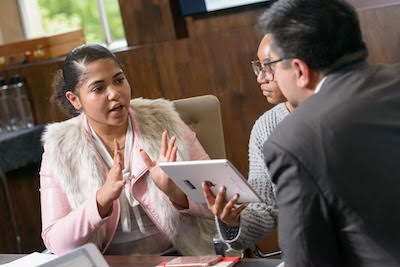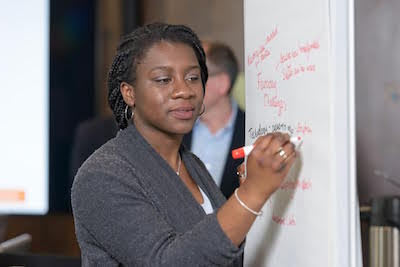The future of science is looking female

INSPIRING: Floriane Fidegnon, Vanessa Madu, Katrine Wandji and Rachel Howsen
WOMEN ARE still underrepresented across all fields of science, making up just 14.4% of the science, tech, engineering and maths (STEM) workforce in the UK. Women of colour – more specifically black women are even more limited in STEM, speaking to a wider issue of gender and racial inequality within STEM employment and education.
While things are gradually changing, there is still a lot more work to be done – and the majority of that is being done by a younger generation of intelligent women making a path for themselves and those following in there footsteps.
Meet Floriane Fidegnon, Vanessa Madu, Katrine Wandji and Rachel Howsen – four Afro-Caribbean students from The Ursuline Academy in Ilford, who are making waves for their growing involvement in the STEM sector. The four ladies were even invited to the IET (Institute of Engineering and Technology) Junior Board, in an attempt to increase diversity and help provide insight into the current engineering and skills shortage in the UK.
“Since meeting with the IET board, I feel like they’re definitely moving in a direction that’s different for them, and they’ve taken on board what we’ve said,” says 18-year-old Fidegnon. “Hopefully in the future, we’ll be seeing some more of what they’re doing and the changes that can me made.”
Fidgenon’s journey into STEM has been a successful one. The talented young woman began when she entered the National Science and Engineering competition in 2013, and her team won the prestigious Shell Prize for Sustainability. Since then, she has remained consistent in her passion for mechanical engineering, resulting in an appearance at the British Science Association Crest Youth Panel to an invite to Buckingham Palace’s garden party. “From the competition, I realised that I’m good at sciences and that I enjoyed it and could forge a great career from it,” she says.
For 17 year-old Madu, the budding mathematician also began her STEM journey through an extra curricular competition. “I was a part of the National Science and Engineering Competition. From there I had the opportunity to present a project to her Royal Highness Princess Anne which was really cool and I continued to develop my interest through writing a STEM related blog.”

Katrine Wandji, 15, during a meeting with the IET Junior Board
The youngest of the girls – Katrine Wandji, 15, just recently became interested in STEM, after attending an initiative aimed at attracting young people into STEM. “In 2015, I went to the Outbox Incubator which is an initiative where girls across Europe learn about science and engineering,” says Wandji. “That’s where my interest in STEM sparked and it made me realise it was something I wanted to do.”
The last of the four ladies, 18-year-old Rachel Howsen, became engaged in STEM and in particular, architecture, in 2012. “Like Floriane and Vanessa, I began my interest in STEM through entering the Science and Engineering Competition which was based on designing a sustainable sports stadium. That really encouraged me into environmental engineering, and it was great to see the possibilities one competition could do for me. From there, I went to more workshops and courses which really delved me into the world of science and STEM.”
For the four students, their specific areas of STEM may vary, but their inspiration remains the same. Their teacher, Rosemary Russell, serves as a great example for empowering women in STEM, and further encouraged them to go into the industry despite the lack of representation within it.

Floriane Fidegnon
“Mrs. Russell was the first person I met in that field because I only recently started to get into STEM,” says Wandji. “Similarly to Mrs. Russell, seeing black women doing STEM and doing it successfully is really encouraging,” adds Fidegnon.
“People like Anne-Marie Imafidon who are really big names in the engineering and tech industry are inspirational to me because they are doing what they want despite the naysayers.”
These naysayers come in the form of people who’ve attempted to discourage the ladies from going into the STEM sector because of the gender and race disparity. With women making up just 8.2% of engineering professionals in the UK, figures like this can easily cast doubt. “When I did work experience and I looked at the whole working floor, I could spot maybe 2 black people, which was very shocking – but I was motivated more so than shocked,” says Howsen.
Read part 2 of The future of science is looking female at 5pm GMT, tomorrow (Sunday 2 July)
Read every story in our hardcopy newspaper for free by downloading the app.






